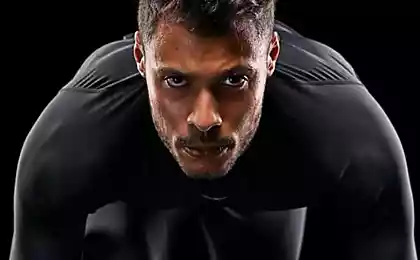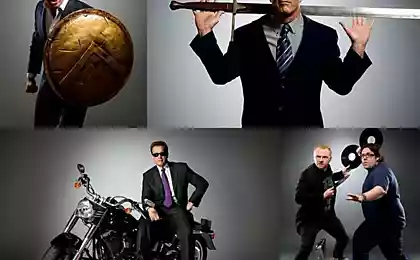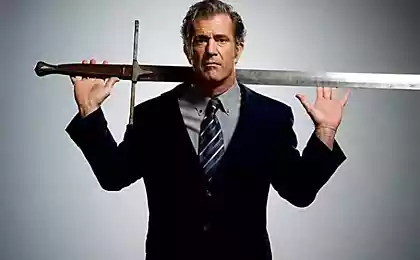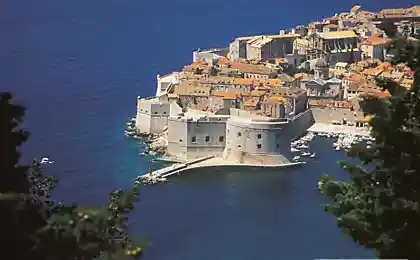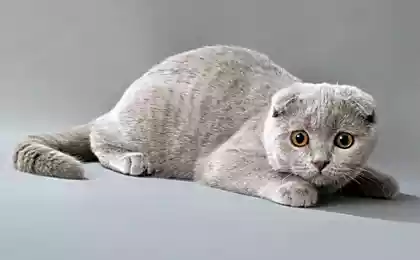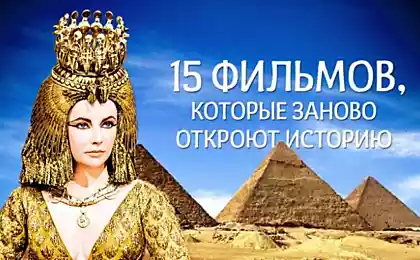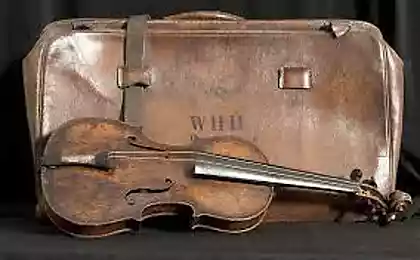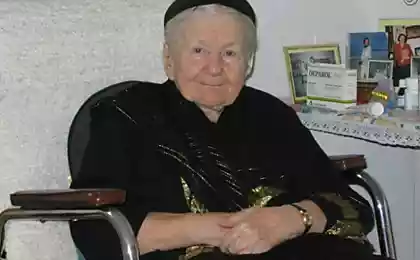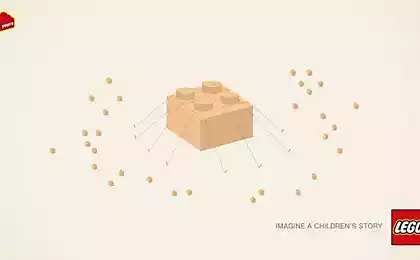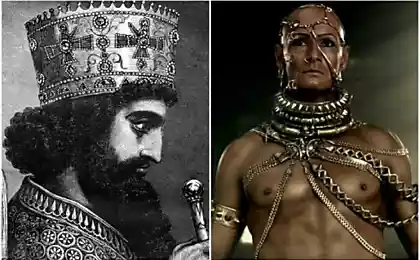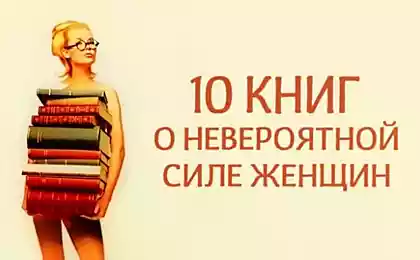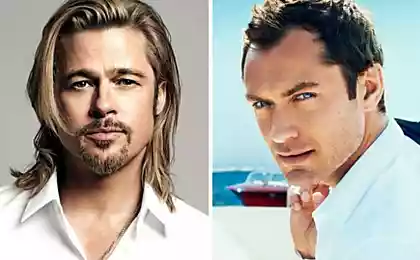1408
"Brave heart". By Wallace to Wallace
Medieval Scottish raises his countrymen to war with the British occupiers and gathers a large army. On the day of the decisive battle, he turns to his soldiers with speech and asks them whether they are ready to fight. Suddenly some soldiers answer that better run away and survive than die in battle with a powerful enemy. Then the hero says, "Right. Fight and you may die. Run, and you'll live. A while. But after many years, dying in their beds, you will be ready to give up all these years for the opportunity to come back here and tell the enemies that they may rob us of our lives, but they will never take our freedom! »
14 photos.

Blockbuster Hollywood movies rarely influences policy. Who in America will invest millions in a movie, which divides society and excites people? But sometimes innocent-looking statement launches ambitious political processes. And that is what happened in Scotland in the mid-1990s - a historical epic Hollywood became the banner and a rallying cry for the fighters for independence. Its director was Mel Gibson, and it was called "Braveheart».
Like many American intellectuals, screenwriter Randall Wallace graduated from high school, university and seminary disaccustomed year (unlike many from Hollywood, he is deeply religious), with only the most cursory idea of the history of Scotland, the country of their ancestors. Why learn what is useless? But when his wife became pregnant and Wallace knew that they would have a son, the writer decided to find out more about their ancestors, that was what to tell the offspring of the origin of their family. So he bought a plane ticket and his wife flew to Edinburgh, Scotland to get to know and its inhabitants.
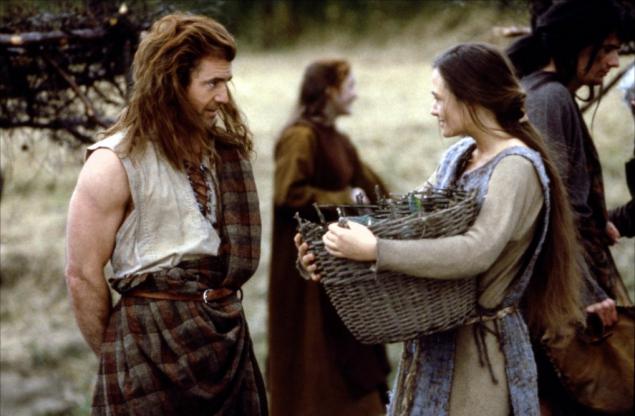
Looking around the city attractions, Wallace drew attention to the statue of his namesake William Wallace installed in Edinburgh Castle. Attached to the plate next to the monument has been said than medieval warrior has earned this honor, and the writer asked the guardian of order, "Who is William Wallace?" "Our greatest hero," - said the guard lock. At this point, the playwright decided that I should write something about the person who is idolized in Scotland, but little known in other countries.
Medieval history - this is known, mostly the story titled rulers, "the anointed of God." You had to be completely unique commoner to please in the ancient chronicles, one page with kings and dukes. And yeoman William Wallace was a member of this club narrow, with celebrities such as Joan of Arc and the leader of the English peasant revolt of Wat Tyler.
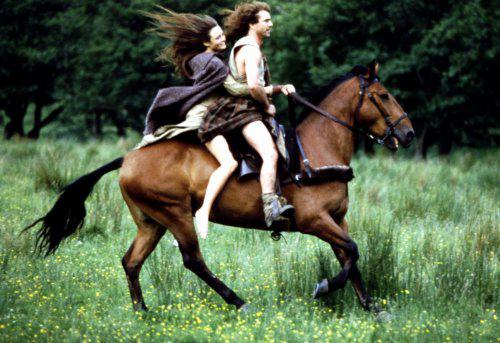
Wallace earned its place on the pedestal in Edinburgh, where in 1297 the Scots in 2300 under his leadership defeated at the Battle of Stirling vastly superior in numbers British army. Eight years later, Wallace had betrayed his allies, and he was under the sentence of King Edward I hanged, beheaded, and quartered (so sophisticated then punished for treason). But they kindled the flame is not extinguished, and in 1328 formally recognized the sovereignty of England northern neighbor. On the Scottish side agreement was signed by King Robert the Bruce - as some believe, one of the aristocrats, whose fault Wallace ended his life on the scaffold.
Although Wallace - a key figure in Scottish history, there was little that it is known. The most detailed medieval source of information about him - composed in the XV century epic poem "Deeds of Sir William Wallace, Knight Elderslie." But who knows how many therefore nicknamed Blind Harry prisochinil to be witty or borrowed from other people's inventions? Therefore, when Randall Wallace undertook to write a script called "Braveheart", he did not feel obliged to scrutinize medieval history and included in the text every little thing known about Wallace. He was much more interesting, for example, a parallel life of a warrior with the life of Christ, as the victim of betrayal and also not defeated executioners. And Wallace decided to come up with a film that would remind young people about the true, traditional male virtues like unconditional love for the homeland, freedom and justice and a willingness to die, not with their heads bowed.

"Pilgrimage" Wallace in Edinburgh took place in 1983, but it is only at the end of the decade decided to present his first screenplay for producer Alan Ladd court (before the "heart" Wallace earned writing for TV). Ladd, famous for the fact that in the mid-1970s was a major ally of George Lucas in the struggle for "Star Wars" (studio Fox has repeatedly endeavoring to close this problem project), since 1985 worked a top manager in MGM. He became interested in the "Heart" and was soon offered a major role Mel Gibson, just who became a Hollywood star thanks to the "Lethal Weapon».
While Gibson took up the role of Wallace, but throw away the script of the actor's head could not. In the early 1990s, Gibson began to think about directing, and during the following years he often pondered and wondering how to put this or that scene. Meanwhile Ladd in 1993 moved from MGM to Paramount, and "Braveheart" was one of the projects that he was able to take home with them.
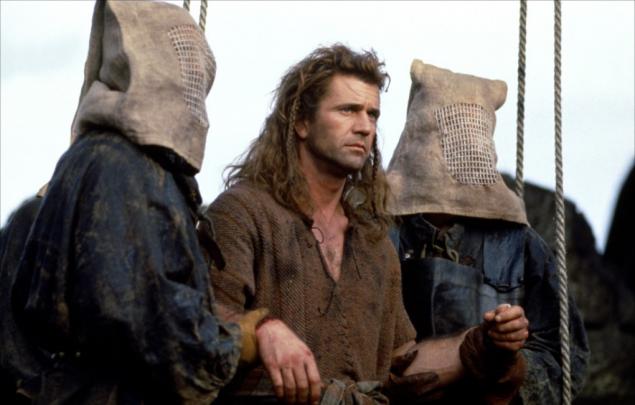
In the same 1993 Gibson made his debut as a director with the teen drama "The Man Without a Face." Actor, Film does not have (while studying in Sydney, he studied theater and not the movie), deliberately chose a simple, chamber tape to in his first film not to dive to a depth of a professional. When the same experiment was successful and "Man" was warmly received by critics, freshly baked director felt that he was ready to take on a much greater scale tape. Therefore, when Ladd again approached him, Gibson announced that he wanted to work on the "heart", but not as an actor but as a director and producer.
Ladd was not against it, and he allowed Gibson to offer the role of Wallace young actor Jason Patric of the "Lost Boys" by Joel Schumacher. The studio, however, refused to invest in the historical film about the not too famous medieval character without superstar face on the poster. Gibson did not relish the prospect of parallel command grandiose shots and play a major role in the film, but he had no choice was - he was at that time how to stick with a project that could not abandon it, or transfer it to another director.
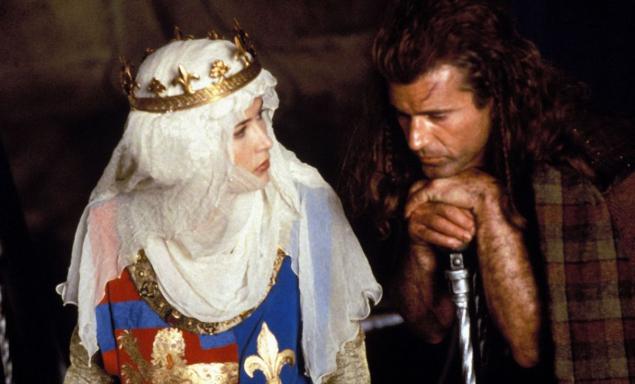
Even with Gibson's producers were able to "roll out" investors "only" $ 70 million. This was a colossal sum by the standards of previous kinoepoh, but in the 1990s it was barely enough for the planned productions with medieval costumes, impressive crowd and several large-scale battles. To invite other superstars are not out of the question - their multimillion-dollar fees bled to budget. Therefore, the key role of Gibson hired, though known, but not super popular (and super expensive) European artists, many of whom "Braveheart" propihnul in Hollywood.
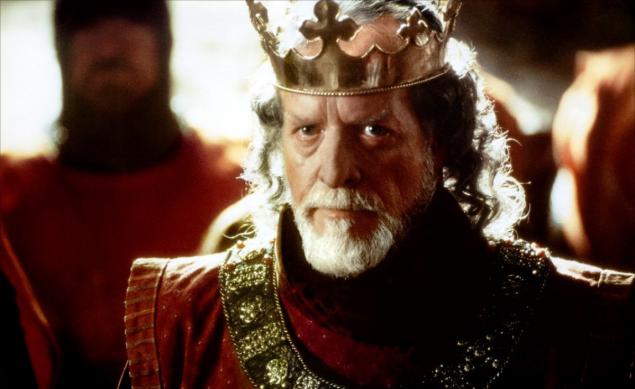
Thus, the role of the English King Edward I was Patrick McGoohan, an elderly American-British actor, best known for the cult British TV series of the 1960s, "The Prisoner" and the horror David Cronenberg's "Scanners". The future of the Scottish king Robert the Bruce depicted Scot Angus Macfadyen (hereinafter - the villain "Equilibrium" hero "Saw 3"), the best friend of the protagonist named Hamish became Brendan Gleeson (later - one of the leading Irish actors), and the French princess Isabella reincarnated future "Bond girl" from "The World Is Not Enough" Sophie Marceau (at that time one of the most successful young actresses in Paris). However, the real Isabella during the term of the tape was a little girl, but the film was needed at least one significant character, and Wallace-writer did not hesitate in this issue (as in many others) to move away from the historical truth.
By bringing in the film mainly English, Irish and Scottish actor, Gibson could not help but worry about how to talk to his players convincing Gaelic accent. Headache least one picture in which the rest of the solid was headache. According to the director, it is for the filming of the constant stress has lost more than five pounds, though not follow the diet and ate everything edible that only caught his eye.
For recreation of medieval Britain in "Braveheart" replied a big team (five alone art directors!) Led by production designer Tom Sanders. They walked along the path already trodden screenwriter. That is thoroughly worked through historical materials (in particular, medieval illustrations and images on gravestones), but did not consider themselves their slaves.
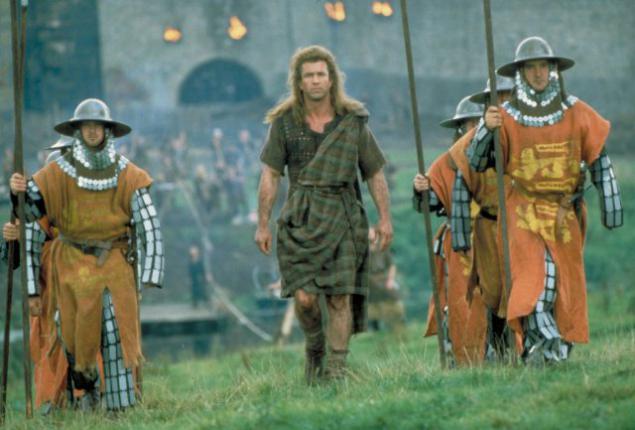
So, Scottish kilts and British military uniforms came into fashion only in the XVII century, but they were still used in the film, so that the audience could easily distinguish between soldiers of opposing armies (in real medieval battle seems to be just the soldiers beat those who seemed to them to strangers ). For the same reason the faces of some of the Scots, including the protagonist, were eerily painted in the style of the ancient Picts were not allowed in Scotland Roman troops. In reality, this tradition by the time Wallace died long ago.
To further emphasize the difference between rich and poor England Scotland, costume used different materials, when inventing and kroili Costumes. Highlanders wore a simple dress of cheap leather and fur, while the English aristocrats sported a luxurious costumes of silk, velvet and Camci. These fabrics, imported from the Middle East during the Crusades, during the time of Wallace's just entered the courtly fashion.
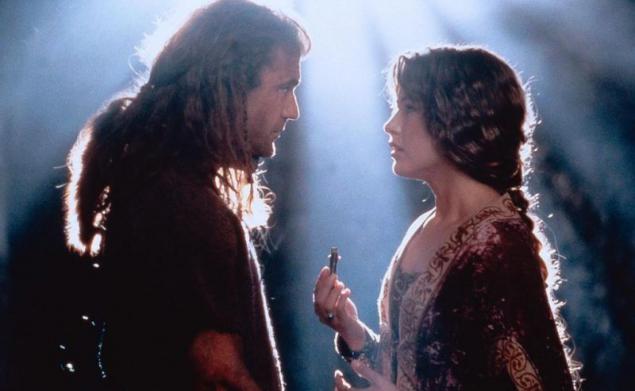
The early scenes of the movie were created mainly in Scotland. Thus, the native village of Wallace was built at the foot of Ben Nevis, the highest peak in the British Isles (it rises to 1,344 meters above sea level), and the interiors of the castle Scottish nobleman Mornay starred in the building of the Edinburgh City Council. However, the main work on the movie took place in Ireland and around Dublin and in the studio Ardmore Studios in Brie, 20 km from the Irish capital. As castles in northern Europe were built on similar plans, decorators did not have to make a special effort to give the Irish medieval buildings for the construction of English and Scottish architects. For the conversion of the ruins of a building full of Hollywood-use add-painted latex under a rock not to damage the ancient attractions.
Why Gibson chose their ancestral homeland homeland Wallace? Firstly, Ireland has provided generous incentives to shoot on its territory filmmakers. Secondly, the local army was willing to provide thousands of soldiers to shoot the battle scenes and the director clearly understood that he needed disciplined extras that do not turn the shooting massacre at present.
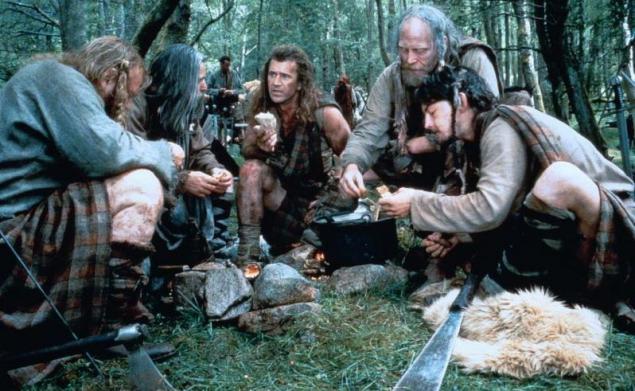
With access to such a large crowd, Gibson could afford to rent even larger massacre than those that fought the real Wallace. The Battle of Stirling, for example, also known as the "Battle of Stirling Bridge" because the Scottish commander of the British used the ferry across the River Forth to smash one by one section English troops. Gibson with screenwriter, however, felt that such a "cowardly" battle unworthy central place in their film, and the Battle of Stirling has been redesigned as a tremendous battle in the open field, removes the plain between Newbridge and Kildare. Only this screen battle involved 3,000 soldiers and 150 horses (as well as several sham, mechanical horses for scenes in which animals are killed). Filming lasted six weeks, and after the Gibson and his editor Steven Rosenblum had to mount a battle of 90 hours of film footage.
Before working on battle scenes Gibson had studied classics, with similar fragments and came to the conclusion that there is little which can learn from them. Battle of old movies seemed to him hard enough and energetic, and too confusing - while watching it was hard to figure out who wins and what maneuvers carried generals. Therefore, in the "heart", he tried to take into account the errors of predecessors and shoot so that the movie captured even connoisseurs of medieval battles.
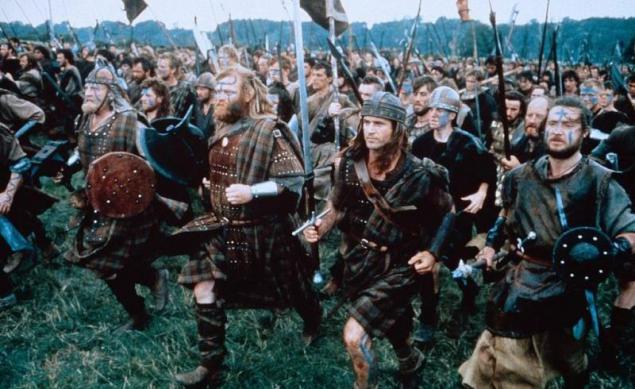
According to Gibson, he never would not cope with this task, if not for his first mate David Tomblin - highly experienced British veteran who worked on the series "Indiana Jones" sequel to "Star Wars," "Superman" and many other epic ribbons . During the filming of 1982 biopic "Gandhi" Tomblin organized funeral scene, which employed 300 thousand extras (this display record was marked by the Guinness World Records). And if Gibson's "Braveheart" was first led crowds subordinates, then Tomblin felt in a project like a fish in water, and he only had one look at the storyboard to determine how many soldiers should get into the scene to seem mighty army, but not to overload the budget. He was also impeccable compiler registers and schedules, and team Gibson compares it with the strict sergeant with talented, but "green" Lieutenant.
In addition to organizing the grand massovok Gibson also fought with the weather. Although "Heart" was filmed in the summer of 1994, the weather in Scotland and in Ireland was soon fall, chilly and rainy. When shooting once visited by Richard Donner, director of "Lethal Weapon" thermophilic from Hollywood had to wear a winter jacket to keep warm. Usually try to wait out bad weather directors, but Gibson quickly realized that the northern rain can not wait - they can just ignore. Fortunately, the rain if not gushing torrents and the action does not develop in a modern city, where the road is clearly visible every puddle, then the audience is difficult to determine whether the frame rain.
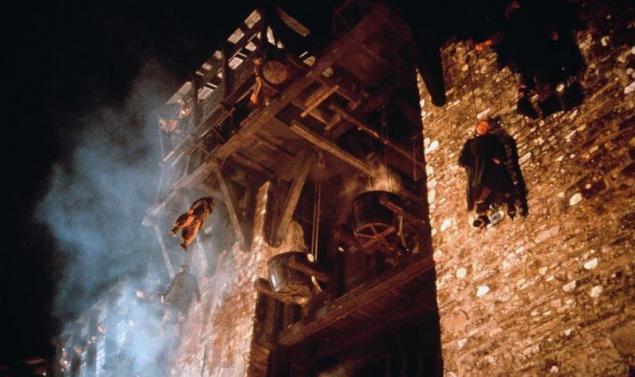
When Gibson finally won weather, dealt with with battle scenes and dialog during installation stung phantasmagoric amount of exposed film to a three-hour epic, it was still one last battle - with the organization MPAA, awarded to the film American ratings. Luckily, MPAA is not too niggles to blockbusters as living on money leading Hollywood studios. Therefore, to obtain a rating of "adult» R instead of the originally nominated film "pornographic» NC-17 Gibson was quite a bit to shorten the fight scenes and the episode penalty Wallace, in order to make them less sadistic.
When May 24, 1995 "Braveheart" were released, it was met with mixed. Critics and audiences admired productions as pathetic and epic historical thriller in the best traditions of the genre, and the band was awarded ten nominations for "Oscar", five of which have turned into statues ("Best Film", "Best Director", "Best Cinematography" "Best Makeup" and "Best Editing sound"). Connoisseurs of history, however, tirelessly denounced biopic as a collection of obvious mistakes - starting with the fact that the action runs through the picture aristocratic "right of first night" (Wallace takes revenge on the British for what they did to his wife), although this right - has long been disproved historians fiction. Long lists of mistakes Gibson and Wallace eventually forced to recognize the "heart" of the inaccurate historical scale tape (unless, of course, does not take into account the postmodern comedy like "World History" Mel Brooks).
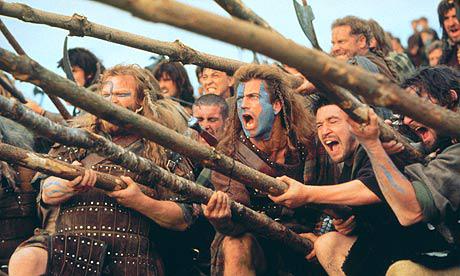
The Scots, however, truly fell in love with movie glorifying their hero and cursing the English invaders. When Gibson arrived at the Scottish premiere in Edinburgh, he was met with the same passion with which Moscow had once met Gagarin. As mentioned earlier in this article, for Scottish patriots "Braveheart" became a symbol of the struggle for independence, and speech of Wallace before the battle of Stirling - the battle cry of the confrontation with the British crown (the peaceful opposition, but inflexible and over the years growing). And if Scotland will soon vote to secede from the United Kingdom, but this is the merit of Gibson, Wallace and colleagues.
Where did the blood stirring words about life and freedom? Not from books and not from books about William Wallace. Although this battle is described in detail in the chronicles, none of them mentions the parting words before the fight, and it is likely that the commander without cost. But medieval warrior - Hollywood, the hero had to say something pathetic in the spirit of the rhetorical frills American generals screen, and because Wallace-writer wrote a monologue that would make him rush on British swords and arrows.
14 photos.

Blockbuster Hollywood movies rarely influences policy. Who in America will invest millions in a movie, which divides society and excites people? But sometimes innocent-looking statement launches ambitious political processes. And that is what happened in Scotland in the mid-1990s - a historical epic Hollywood became the banner and a rallying cry for the fighters for independence. Its director was Mel Gibson, and it was called "Braveheart».
Like many American intellectuals, screenwriter Randall Wallace graduated from high school, university and seminary disaccustomed year (unlike many from Hollywood, he is deeply religious), with only the most cursory idea of the history of Scotland, the country of their ancestors. Why learn what is useless? But when his wife became pregnant and Wallace knew that they would have a son, the writer decided to find out more about their ancestors, that was what to tell the offspring of the origin of their family. So he bought a plane ticket and his wife flew to Edinburgh, Scotland to get to know and its inhabitants.

Looking around the city attractions, Wallace drew attention to the statue of his namesake William Wallace installed in Edinburgh Castle. Attached to the plate next to the monument has been said than medieval warrior has earned this honor, and the writer asked the guardian of order, "Who is William Wallace?" "Our greatest hero," - said the guard lock. At this point, the playwright decided that I should write something about the person who is idolized in Scotland, but little known in other countries.
Medieval history - this is known, mostly the story titled rulers, "the anointed of God." You had to be completely unique commoner to please in the ancient chronicles, one page with kings and dukes. And yeoman William Wallace was a member of this club narrow, with celebrities such as Joan of Arc and the leader of the English peasant revolt of Wat Tyler.

Wallace earned its place on the pedestal in Edinburgh, where in 1297 the Scots in 2300 under his leadership defeated at the Battle of Stirling vastly superior in numbers British army. Eight years later, Wallace had betrayed his allies, and he was under the sentence of King Edward I hanged, beheaded, and quartered (so sophisticated then punished for treason). But they kindled the flame is not extinguished, and in 1328 formally recognized the sovereignty of England northern neighbor. On the Scottish side agreement was signed by King Robert the Bruce - as some believe, one of the aristocrats, whose fault Wallace ended his life on the scaffold.
Although Wallace - a key figure in Scottish history, there was little that it is known. The most detailed medieval source of information about him - composed in the XV century epic poem "Deeds of Sir William Wallace, Knight Elderslie." But who knows how many therefore nicknamed Blind Harry prisochinil to be witty or borrowed from other people's inventions? Therefore, when Randall Wallace undertook to write a script called "Braveheart", he did not feel obliged to scrutinize medieval history and included in the text every little thing known about Wallace. He was much more interesting, for example, a parallel life of a warrior with the life of Christ, as the victim of betrayal and also not defeated executioners. And Wallace decided to come up with a film that would remind young people about the true, traditional male virtues like unconditional love for the homeland, freedom and justice and a willingness to die, not with their heads bowed.

"Pilgrimage" Wallace in Edinburgh took place in 1983, but it is only at the end of the decade decided to present his first screenplay for producer Alan Ladd court (before the "heart" Wallace earned writing for TV). Ladd, famous for the fact that in the mid-1970s was a major ally of George Lucas in the struggle for "Star Wars" (studio Fox has repeatedly endeavoring to close this problem project), since 1985 worked a top manager in MGM. He became interested in the "Heart" and was soon offered a major role Mel Gibson, just who became a Hollywood star thanks to the "Lethal Weapon».
While Gibson took up the role of Wallace, but throw away the script of the actor's head could not. In the early 1990s, Gibson began to think about directing, and during the following years he often pondered and wondering how to put this or that scene. Meanwhile Ladd in 1993 moved from MGM to Paramount, and "Braveheart" was one of the projects that he was able to take home with them.

In the same 1993 Gibson made his debut as a director with the teen drama "The Man Without a Face." Actor, Film does not have (while studying in Sydney, he studied theater and not the movie), deliberately chose a simple, chamber tape to in his first film not to dive to a depth of a professional. When the same experiment was successful and "Man" was warmly received by critics, freshly baked director felt that he was ready to take on a much greater scale tape. Therefore, when Ladd again approached him, Gibson announced that he wanted to work on the "heart", but not as an actor but as a director and producer.
Ladd was not against it, and he allowed Gibson to offer the role of Wallace young actor Jason Patric of the "Lost Boys" by Joel Schumacher. The studio, however, refused to invest in the historical film about the not too famous medieval character without superstar face on the poster. Gibson did not relish the prospect of parallel command grandiose shots and play a major role in the film, but he had no choice was - he was at that time how to stick with a project that could not abandon it, or transfer it to another director.

Even with Gibson's producers were able to "roll out" investors "only" $ 70 million. This was a colossal sum by the standards of previous kinoepoh, but in the 1990s it was barely enough for the planned productions with medieval costumes, impressive crowd and several large-scale battles. To invite other superstars are not out of the question - their multimillion-dollar fees bled to budget. Therefore, the key role of Gibson hired, though known, but not super popular (and super expensive) European artists, many of whom "Braveheart" propihnul in Hollywood.

Thus, the role of the English King Edward I was Patrick McGoohan, an elderly American-British actor, best known for the cult British TV series of the 1960s, "The Prisoner" and the horror David Cronenberg's "Scanners". The future of the Scottish king Robert the Bruce depicted Scot Angus Macfadyen (hereinafter - the villain "Equilibrium" hero "Saw 3"), the best friend of the protagonist named Hamish became Brendan Gleeson (later - one of the leading Irish actors), and the French princess Isabella reincarnated future "Bond girl" from "The World Is Not Enough" Sophie Marceau (at that time one of the most successful young actresses in Paris). However, the real Isabella during the term of the tape was a little girl, but the film was needed at least one significant character, and Wallace-writer did not hesitate in this issue (as in many others) to move away from the historical truth.
By bringing in the film mainly English, Irish and Scottish actor, Gibson could not help but worry about how to talk to his players convincing Gaelic accent. Headache least one picture in which the rest of the solid was headache. According to the director, it is for the filming of the constant stress has lost more than five pounds, though not follow the diet and ate everything edible that only caught his eye.
For recreation of medieval Britain in "Braveheart" replied a big team (five alone art directors!) Led by production designer Tom Sanders. They walked along the path already trodden screenwriter. That is thoroughly worked through historical materials (in particular, medieval illustrations and images on gravestones), but did not consider themselves their slaves.

So, Scottish kilts and British military uniforms came into fashion only in the XVII century, but they were still used in the film, so that the audience could easily distinguish between soldiers of opposing armies (in real medieval battle seems to be just the soldiers beat those who seemed to them to strangers ). For the same reason the faces of some of the Scots, including the protagonist, were eerily painted in the style of the ancient Picts were not allowed in Scotland Roman troops. In reality, this tradition by the time Wallace died long ago.
To further emphasize the difference between rich and poor England Scotland, costume used different materials, when inventing and kroili Costumes. Highlanders wore a simple dress of cheap leather and fur, while the English aristocrats sported a luxurious costumes of silk, velvet and Camci. These fabrics, imported from the Middle East during the Crusades, during the time of Wallace's just entered the courtly fashion.

The early scenes of the movie were created mainly in Scotland. Thus, the native village of Wallace was built at the foot of Ben Nevis, the highest peak in the British Isles (it rises to 1,344 meters above sea level), and the interiors of the castle Scottish nobleman Mornay starred in the building of the Edinburgh City Council. However, the main work on the movie took place in Ireland and around Dublin and in the studio Ardmore Studios in Brie, 20 km from the Irish capital. As castles in northern Europe were built on similar plans, decorators did not have to make a special effort to give the Irish medieval buildings for the construction of English and Scottish architects. For the conversion of the ruins of a building full of Hollywood-use add-painted latex under a rock not to damage the ancient attractions.
Why Gibson chose their ancestral homeland homeland Wallace? Firstly, Ireland has provided generous incentives to shoot on its territory filmmakers. Secondly, the local army was willing to provide thousands of soldiers to shoot the battle scenes and the director clearly understood that he needed disciplined extras that do not turn the shooting massacre at present.

With access to such a large crowd, Gibson could afford to rent even larger massacre than those that fought the real Wallace. The Battle of Stirling, for example, also known as the "Battle of Stirling Bridge" because the Scottish commander of the British used the ferry across the River Forth to smash one by one section English troops. Gibson with screenwriter, however, felt that such a "cowardly" battle unworthy central place in their film, and the Battle of Stirling has been redesigned as a tremendous battle in the open field, removes the plain between Newbridge and Kildare. Only this screen battle involved 3,000 soldiers and 150 horses (as well as several sham, mechanical horses for scenes in which animals are killed). Filming lasted six weeks, and after the Gibson and his editor Steven Rosenblum had to mount a battle of 90 hours of film footage.
Before working on battle scenes Gibson had studied classics, with similar fragments and came to the conclusion that there is little which can learn from them. Battle of old movies seemed to him hard enough and energetic, and too confusing - while watching it was hard to figure out who wins and what maneuvers carried generals. Therefore, in the "heart", he tried to take into account the errors of predecessors and shoot so that the movie captured even connoisseurs of medieval battles.

According to Gibson, he never would not cope with this task, if not for his first mate David Tomblin - highly experienced British veteran who worked on the series "Indiana Jones" sequel to "Star Wars," "Superman" and many other epic ribbons . During the filming of 1982 biopic "Gandhi" Tomblin organized funeral scene, which employed 300 thousand extras (this display record was marked by the Guinness World Records). And if Gibson's "Braveheart" was first led crowds subordinates, then Tomblin felt in a project like a fish in water, and he only had one look at the storyboard to determine how many soldiers should get into the scene to seem mighty army, but not to overload the budget. He was also impeccable compiler registers and schedules, and team Gibson compares it with the strict sergeant with talented, but "green" Lieutenant.
In addition to organizing the grand massovok Gibson also fought with the weather. Although "Heart" was filmed in the summer of 1994, the weather in Scotland and in Ireland was soon fall, chilly and rainy. When shooting once visited by Richard Donner, director of "Lethal Weapon" thermophilic from Hollywood had to wear a winter jacket to keep warm. Usually try to wait out bad weather directors, but Gibson quickly realized that the northern rain can not wait - they can just ignore. Fortunately, the rain if not gushing torrents and the action does not develop in a modern city, where the road is clearly visible every puddle, then the audience is difficult to determine whether the frame rain.

When Gibson finally won weather, dealt with with battle scenes and dialog during installation stung phantasmagoric amount of exposed film to a three-hour epic, it was still one last battle - with the organization MPAA, awarded to the film American ratings. Luckily, MPAA is not too niggles to blockbusters as living on money leading Hollywood studios. Therefore, to obtain a rating of "adult» R instead of the originally nominated film "pornographic» NC-17 Gibson was quite a bit to shorten the fight scenes and the episode penalty Wallace, in order to make them less sadistic.
When May 24, 1995 "Braveheart" were released, it was met with mixed. Critics and audiences admired productions as pathetic and epic historical thriller in the best traditions of the genre, and the band was awarded ten nominations for "Oscar", five of which have turned into statues ("Best Film", "Best Director", "Best Cinematography" "Best Makeup" and "Best Editing sound"). Connoisseurs of history, however, tirelessly denounced biopic as a collection of obvious mistakes - starting with the fact that the action runs through the picture aristocratic "right of first night" (Wallace takes revenge on the British for what they did to his wife), although this right - has long been disproved historians fiction. Long lists of mistakes Gibson and Wallace eventually forced to recognize the "heart" of the inaccurate historical scale tape (unless, of course, does not take into account the postmodern comedy like "World History" Mel Brooks).

The Scots, however, truly fell in love with movie glorifying their hero and cursing the English invaders. When Gibson arrived at the Scottish premiere in Edinburgh, he was met with the same passion with which Moscow had once met Gagarin. As mentioned earlier in this article, for Scottish patriots "Braveheart" became a symbol of the struggle for independence, and speech of Wallace before the battle of Stirling - the battle cry of the confrontation with the British crown (the peaceful opposition, but inflexible and over the years growing). And if Scotland will soon vote to secede from the United Kingdom, but this is the merit of Gibson, Wallace and colleagues.
Where did the blood stirring words about life and freedom? Not from books and not from books about William Wallace. Although this battle is described in detail in the chronicles, none of them mentions the parting words before the fight, and it is likely that the commander without cost. But medieval warrior - Hollywood, the hero had to say something pathetic in the spirit of the rhetorical frills American generals screen, and because Wallace-writer wrote a monologue that would make him rush on British swords and arrows.


